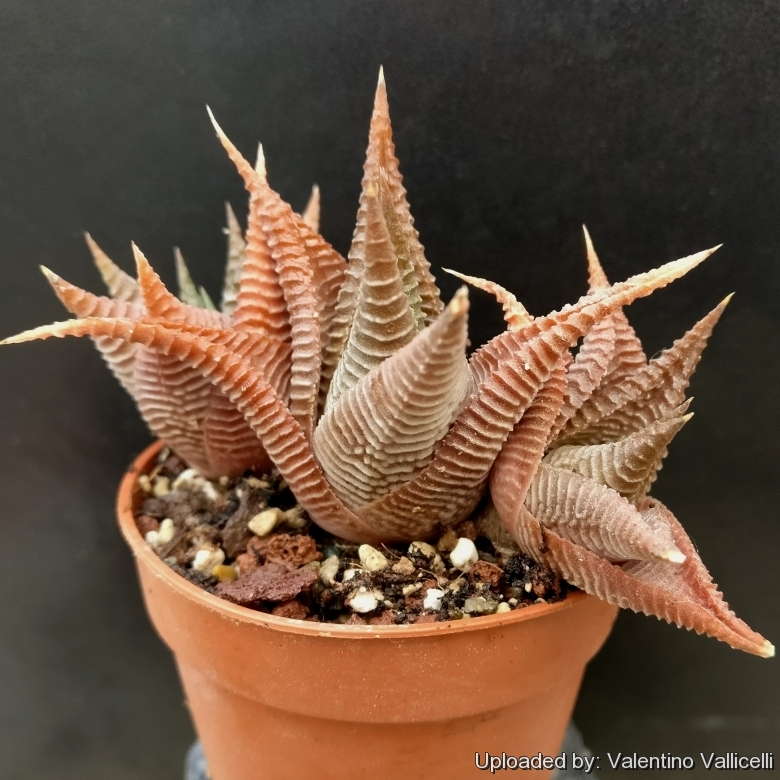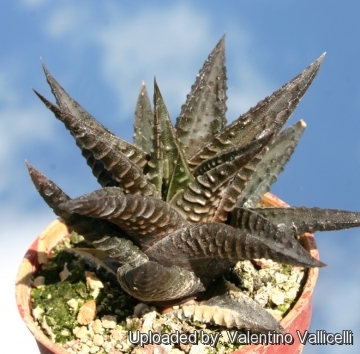Accepted Scientific Name: Haworthia limifolia Marloth
Trans. Roy. Soc. South Africa 1: 409 1910

Haworthiopsis limifolia (Haworthia limifolia) Photo by: Valentino Vallicelli
Origin and Habitat: Mozambique, Swaziland, Republic of South Africa (Mpumalanga, KwaZulu-Natal)
Synonyms:
See all synonyms of Haworthia limifolia
Common Names include:
ENGLISH: File Leafed Haworthia, Fairies Washboard
Description: Haworthia limifoliaSN|21354]]SN|21354]] is a charming species, with large rosettes. It obtained its name “limifolia” (File Leafed) from the distinctive, dark brownish-green leaves, with transverse ridges of raised, horny, tubercles which resemble those of a coarse file and give it such a distinctive appearance.
Rosettes: Stemless, solitary or slowly proliferating with or without stolons and forming clumps of up to 20 rosettes, each rosette being 5-6 cm in diameter. The rosettes bear 12-30 broad triangular leaves giving them a characteristic pinwheel-like shape.
Note: Several robust clones, with larger rosettes up to 12(-15) cm in diameter has been selected and propagated ans a variegated form ( Haworthia limifoliaSN|21354]]SN|21354]] f. variegata) is also known and very priced in cultivation.
Leaves: Triangular to ovate-lanceolate, spreading, very broad at the base to 6 (or more) cm long, 2 (or more) cm broad, light to very dark green and even brownish-green, opaque, scabrid with shining white or concolorous, pronounced tubercles often merging together into confluent transverse ridges, margins and keel scabrid or with teeth.
Inflorescence: Slender, to 35 cm.
Flowers: 15-20, slender. Tepals tips revolute. The flower's Structure, colour and fruits are typical of the genus.
Subspecies, varieties, forms and cultivars of plants belonging to the Haworthia limifolia group
Bibliography: Major references and further lectures
1) Gordon D. Rowley “The illustrated encyclopedia of succulents” Crown Publishers, 01/Aug/1978
2)John Robert Brown “Unusual Plants: 110 Spectacular Photographs of Succulents” Abbey Garden Press, 1954
3) Urs Eggli “Illustrated Handbook of Succulent Plants: Monocotyledons” Springer, 2001
4) Charles L. Scott “The genus Haworthia (Liliaceae): a taxonomic revision” Aloe Books, 1985
5) Stuart Max Walters “The European Garden Flora: Pteridophyta, Gymbospermae, Angiospermae-Monocotyledons” Cambridge University Press, 1984
6) M. B. Bayer “The new Haworthia handbook” National Botanic Gardens of South Africa, 1982
7) John Pilbeam “Haworthia and Astroloba: A Collector's Guide” B. T. Batsford Limited, 1983
8) Bruce Bayer “Haworthia revisited: a revision of the genus” Umdaus Press, 1999
9) David Hardy, Anita Fabian, Gerrit Germishuizen “Succulents of the Transvaal” Southern Book Publishers, 1992
10) Rudolf Marloth “Some new South African Succulents. Part II.” Transactions of the Royal Society of South Africa. Volume 1, n 2, pag. 409, 1910
 Haworthiopsis limifolia (Haworthia limifolia) Photo by: Valentino Vallicelli
Haworthiopsis limifolia (Haworthia limifolia) Photo by: Valentino Vallicelli Haworthiopsis limifolia (Haworthia limifolia) Photo by: Valentino Vallicelli
Haworthiopsis limifolia (Haworthia limifolia) Photo by: Valentino VallicelliCultivation and Propagation: Haworthia are of easy cultivation and relatively low maintenance, which makes them a good houseplant, and can be an excellent subject for the beginning succulentophile (they can grow easily on window sills, verandas and in miniature succulent gardens where they are happy to share their habitat with other smaller succulent plants, or in outdoor rockeries). Haworthias are winter growers and are dormant in the hottest summer months.
Growth rate: They are relatively fast-growing plants that offsets freely to form small clusters quickly.
Soil: They are tolerant of a wide range of soils and habitats, but prefer a very porous potting mix to increase drainage. A non-acid soil is ideal. You can grow a plant in a 10-15 cm pot for years and have perfectly happy plants. For best results, use a shallow pot.
Exposition: The plant needs light shade to shade, but will take full sun part of the day. (with some sun exposure the leaf develops a nice reddish tint and remains compact).
Watering: During the hot summer months, the soil should be kept moist but not overly wet. During the winter months, water only when the soil becomes completely dry. Wet soil quickly causes root and stem rot, especially during chilly winter months. No water should ever be allowed to stand around the roots. Low ambient humidity is always needed.
Fertilization: The plants are fertilized only once during the growing season with a balanced fertilizer diluted to ½ the recommended strength.
Hardiness: Although the plant will survive mild frost if kept dry (hardy as low as -5° C) it should be protected from severe cold and prolonged frost conditions.
Rot: Rot is only a minor problem with Haworthia if the plants are watered and “aired” correctly. If they are not, fungicides won't help all that much. Care must be given in watering, keeping them warm and wet while growing, and cooler and dry when dormant.
Remarks: Haworthias are best planted in a shaded and airy part of the greenhouse, and not too close to the glass roof or sides of the house as the plants can overheat during hot spells.
Propagation: Haworthia are easily propagated by the removal of offshoots or by leaf cuttings in spring or summer. To propagate by leaf cuttings, remove a leaf and let it lie for about one month, giving the wound time to heal. Then lay the leaf on its side with the basal part buried in the soil. This leaf should root within a month or two, and small plants will form at the leaf base. They can also be grown from seed.












